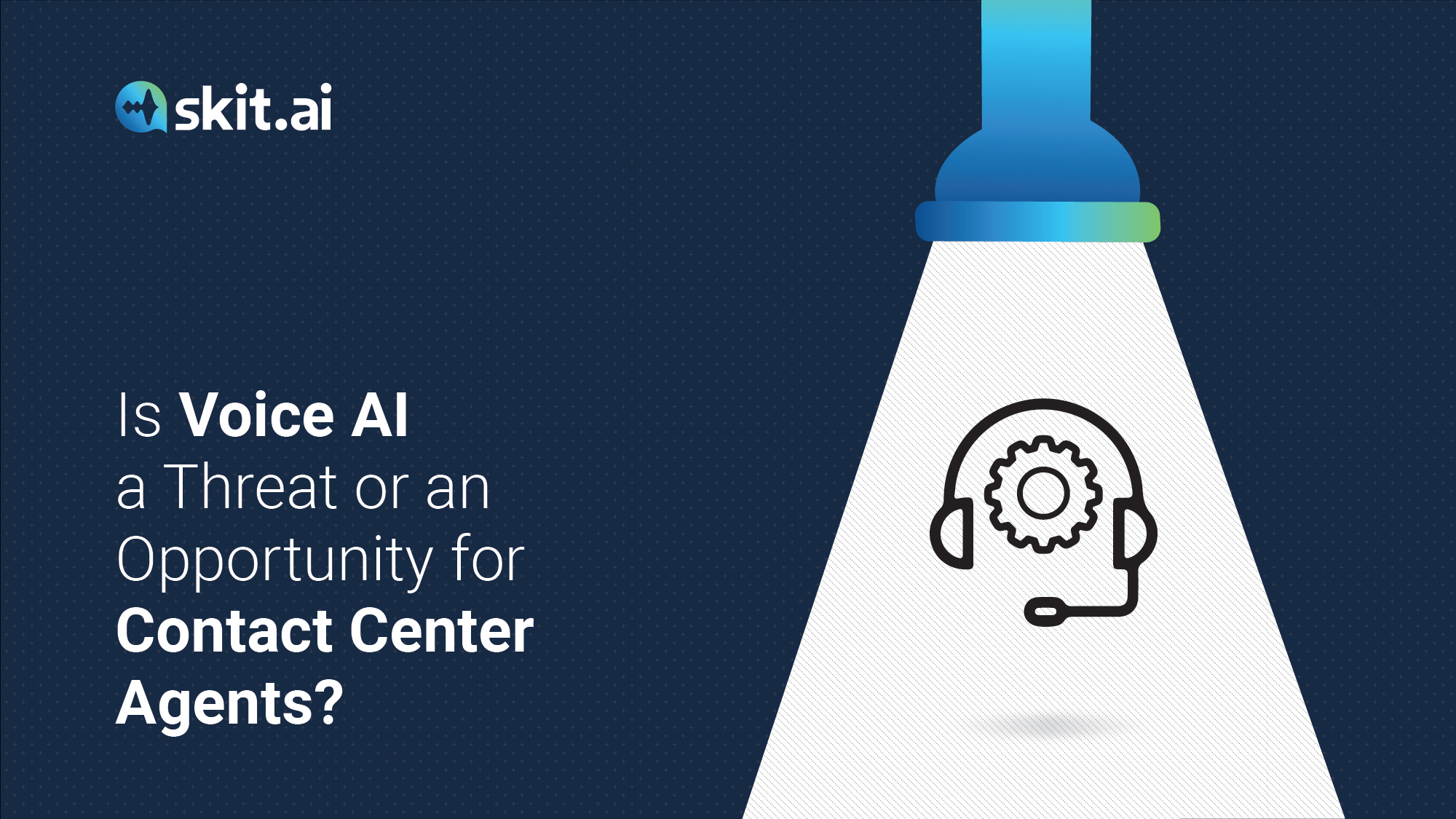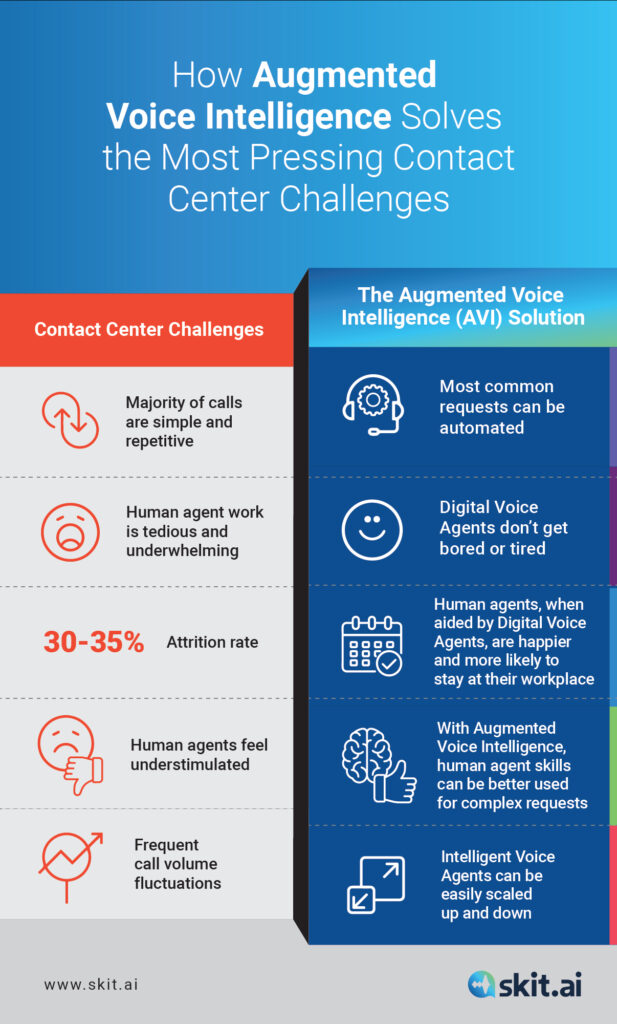Simone Somekh
July 11, 2022

Hello! Welcome to Skit.ai. Click here to book a demo.
July 11, 2022

The artificial intelligence industry is growing at vertiginous speed; a recent study valued the global AI market size at $87 billion in 2021, and estimated a CAGR of 38.1% from 2022 to 2030. Voice AI is one of the most promising technological applications of artificial intelligence.
Whenever these numbers are reported, it’s common to see some familiar headlines in the news and on LinkedIn: “AI is coming for your job,” “AI is eating up the workforce,” and so on. This narrative, however, is not accurate.
Voice AI has the unparalleled ability to shift the way contact centers function by automating countless customer interactions and lifting the weight of tedious, repetitive tasks off the shoulders of customer service agents. But does that mean that AI will take away jobs in customer service?
In this article, we’ll unpack how Voice AI affects contact centers, human agents, and operations.
Rather than taking away jobs, Voice AI is more likely to take over specific tasks and activities that are currently performed by human workers.
While all types of jobs are likely to be affected in some way by automation, McKinsey estimates that only 5% of jobs could be fully automated with the AI technology we have today. Some of the fields that are likely to be most affected by AI are customer service and data-related jobs, such as data entry, collection, and processing.
Here is a summary of how an Augmented Voice Intelligence (AVI) solution can help solve the most pressing contact center challenges; below, we’ll dive deeper into each point, explaining how AVI can empower human agents.

Let’s look at the issue from the human agent’s perspective.
At a busy time, a contact center receives multiple inquiries per minute. However, the vast majority of calls and requests that contact centers receive are simple and repetitive. The work of human agents therefore tends to be tedious and underwhelming.
A Digital Voice Agent is able to sort through the inbound calls and manage those basic tasks.
The same idea applies to contact centers that mostly focus on outbound calls; a Digital Voice Agent can proactively initiate outbound calls to users at a scale that would be impossible for a human agent.
Mundane tasks that can be easily automated include authenticating callers, providing account balances, and updating phone numbers and addresses.
The Digital Voice Agent can redirect the more complex requests to the human agents, whose skills can be best used for such requests. If the caller needs to speak with a human agent, the transfer is contextual and intelligent. This way, human agents will address more interesting or pressing issues, and will feel more helpful and stimulated.
Rather than “taking away” the human agents’ jobs, Voice AI can actually make their jobs more pleasant and help them focus on more interesting issues in their day-to-day work.
Read more: Voice AI: The Biggest Contact Center Automation Trend of 2022
Now let’s take into consideration the contact center management’s perspective.
The challenge of managing a contact center can be easily identified when looking at attrition rates. The current data suggests that contact centers have approximately a 35-40% attrition rate. This places an enormous strain on customer-facing enterprises; it takes approximately eight months to hire, onboard, and train a new agent.
According to a McKinsey report, satisfied contact center employees are 8.5 times more likely to stay at their workplace than leave within a year.
Another major issue contact centers face is the volatility and seasonality of the work.
Let’s say your contact center faces an unforeseeable situation which causes a massive surge in inbound calls. All of a sudden, you need many more agents available to take the calls. Scaling up and down so fast is not possible.
Voice AI eliminates this problem, as it’s easy to scale up and down as needed, managing call fluctuations and seasonal changes.
Whenever a new technology emerges, people fear that it can pose a threat. Just think of the First Industrial Revolution as an example; during this time, industrialization was at first seen as a threat. A similar thing happened at the beginning of the Digital Revolution, especially with the introduction of home computers and the subsequent digitization of data.
The idea that within a few years robots will completely replace human agents at contact centers is not very realistic. The most likely path to success will consist in a collaboration between voice bots and humans.
A seamless customer experience requires a combination of efficiency, effectiveness, and empathy, and that can only be achieved with a combination of human and automated efforts—what we call augmented intelligence.
While Voice AI can help enormously to improve speed and effectiveness of a customer service response, bots are unlikely to be able to substitute the empathy needed to assist a customer with a more challenging or complex issue to solve.
In most cases, AI doesn’t learn new information and acquire new skills on its own. It requires specialized engineers who prepare the data, determine datasets, remove any possible bias, train, and update the software on a regular basis to integrate the knowledge and prepare a learning cycle. Only at that point, the AI can be used to aid human agents.
The space that Skit.ai has created is Augmented Voice Intelligence. The name itself acknowledges the importance of a partnership between humans and machines. Through Augmented Voice Intelligence (AVI), contact centers can enhance their operations and better retain human agents.
The business experience of the future is going to strongly rely on this cooperation between humans and AI.
For more information and a free demo, you can schedule a call with one of our experts.
The auto finance industry is experiencing significant transformations driven by market dynamics, consumer behavior, and technological innovations. Here are the key trends shaping the future of auto finance, focusing on the implications for Buy Here Pay Here (BHPH) dealers and the role of Conversational AI and contact center automation in streamlining operations, which will help […]
The auto finance industry, a crucial pillar in the automotive market, experienced a turbulent Q2 in 2024. The rise of delinquent accounts in subprime lending has become a significant concern for industry stakeholders. Subprime lending, which targets borrowers with lower credit scores, is inherently riskier, and recent economic pressures have worsened these risks. This blog […]